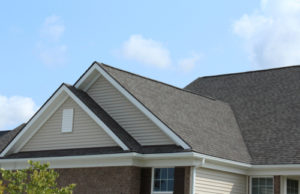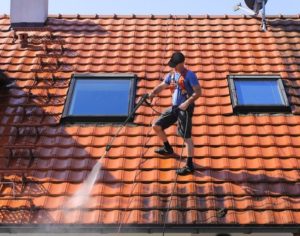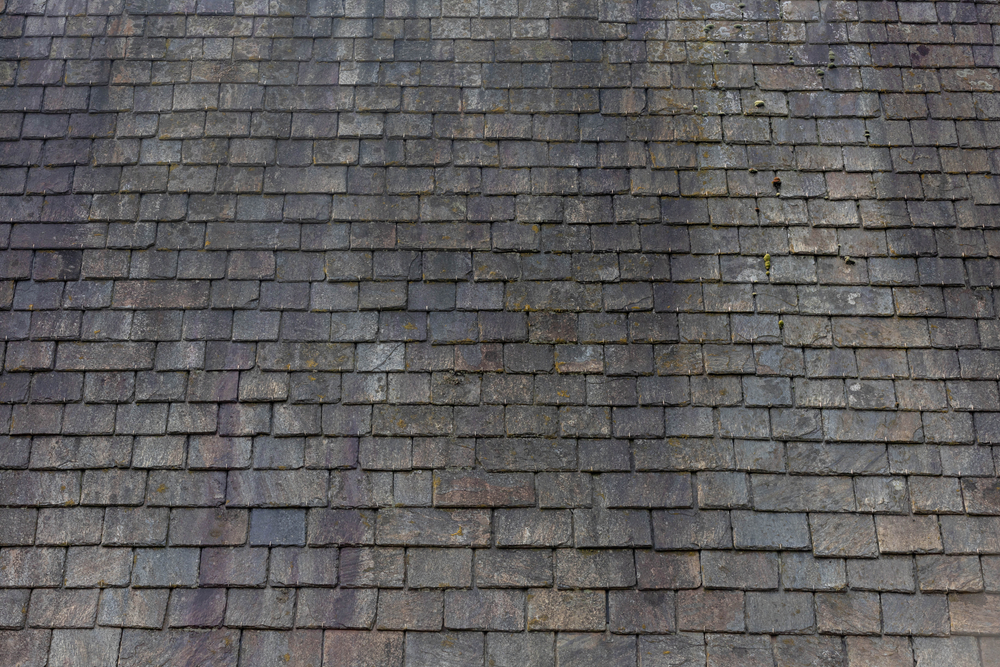The roof over our head protects us from rain, storms, and other environmental elements. That’s why it’s important to keep an eye on your roof and make sure it’s in tip-top shape. Leaving unaddressed damage can lead to further expenses and hassle down the road. Common sources of damage to roofing include rain, wind, mold, storm damage, algae, bacteria, and human error.
Today we will talk about roof stains, one of the most common types of roofing damage seen in homes. Let’s start with the basics first, though.
What Are Roof Stains?
It’s not uncommon to see dark stains and streaks on your roof, especially if some time has passed since its installation. Although a variety of factors can cause these stains, the most common one is algae. According to the International Institute of Building Enclosure Consultants (IIBEC), algae is seen on roofs in over 80% of the US.
The most likely type of algae to cause these roof stains is gloeocapsa magma, otherwise known as blue-green algae.
As gloeocapsa magma accumulates, they slowly begin developing a dark outer coating, resulting in the black streaks that you see on your roof.
These roof stains are not only unsightly but also a risk to your roof’s health if left untreated. The algae can eat away at shingles, leaving holes and damaged sections of roofing. This, in turn, can cause water leaks and lead to further damage down the road. So although it’s not an immediate threat, algae should be cleaned off your roof sooner rather than later.
What Causes Black Streaks On Roof Shingles?
As we’ve already mentioned, the primary culprit of those unsightly black streaks on your roof is probably algae. To be more specific, however, let’s take a look at why they accumulate in certain areas.
Algae needs a couple of things to thrive – heat, moisture, and nutrients of some kind. Unfortunately, your roof actually provides all of these things in spades. Those humid, sunny days during the summer create a perfect environment for algae. That’s why you might find algae more common in some regions of the US – think wet, humid areas.
The third ingredient is nutrition. This factor depends on your roofing material. To be more specific, algae typically feeds on the limestone found in many types of shingles. That’s why homeowners with asphalt shingles or concrete tiles often find themselves fighting algae more frequently. Wood may be another high-risk material when it comes to unwelcome algae buildups.
How To Prevent Roof Stains

Unfortunately, algae spores are naturally disseminated by wind and are therefore hard to completely prevent. Having said that, there are a number of ways to decrease your chances of having an algae infestation.
As we’ve already mentioned, algae tend to be attracted to certain types of roofing material. Anything that algae can potentially feed on is a detriment to your roof’s health. Stay away from high-risk materials such as asphalt.
There are even roof shingles that are specifically designed to be algae-resistant. If you live in a region that’s at high risk of algae growth, it might be a good idea to ask your roofing contractor about such options. Algae-resistant shingles will typically contain metal granules that keep algae at bay.
In addition to this, you can always reach out to a roofing expert in regards to putting some preventative measures in place. A roofing contractor can install strips of zinc or copper metal along the sides of your roof. Since these metals are toxic to algae, rainwater that touches these metals and trickles down your roof will kill algae that it comes into contact with.
Last of all, keeping an eye on your roof’s general health is always a good preventative measure. Water leaks and poor drainage can lead to an increase in algae growth. Likewise, letting existing algae fester can cause problems down the road, so make sure to check on your roof’s health every once in a while. A professional roofing company can also perform roofing examinations, so don’t hesitate to get some expert help if you need it.
How To Clean Roof Stains

As we mentioned earlier, black roof stains are not an immediate risk to your roof. However, they are a risk if left untreated for long periods of time. So if you notice black streaks on your roof, it’s best to address them relatively soon.
DIY
The cheapest way to get rid of roof stains is to do it yourself. Since algae can get very slippery, it can be dangerous to attempt to clean it yourself. The safest option is almost always to hire a roofing contractor or company.
Having said that, if you do decide to tackle this cleaning job yourself, consider these things:
Weather – Heavy rain can wash away the solution prematurely, and winds can blow the spray away. It’s best to choose a sunny day that’s good for roof work.
Chemicals – Don’t use a “homemade” cleaner. Instead, do some research and select a professional roof cleaning solution. Using 100% bleach or other very harsh chemicals can further damage shingles rather than cleaning them.
The Process – Always do your research, watch some videos, and prepare all of the necessary equipment beforehand. Typically, most roof cleaning solutions will have you spray the solution on and then rinse it off after killing the algae. Make sure to follow the directions on the packaging. Some solutions have a wait time or additional ingredients you have to mix in.
Most of all, however, stay safe. Remember that algae can create a very slippery surface, so good shoes and planning is a must. Having someone you can call for help in case of an emergency may be a good idea as well.
Hiring a Professional
As we mentioned earlier, hiring a roofing specialist is by far the safest way to clean a roof that has collected algae.
When choosing a contractor, keep these things in mind:
Credentials – Is your roofing contractor licensed? A license proves that they are a specialist who has undergone extensive training, examinations, and has referrals. Most importantly, however, a license guarantees that the contractor is insured for their work. This protects both the contractor and you.
Experience – Does your contractor know what they’re doing? For example, here at Austermiller Roofing, we have 25+ years of experience servicing roofs. This means that we’ve seen it all and we can provide you with quality workmanship.
Pricing – Always ask for an estimate before moving forward with roofing repairs. Austermiller offers low rates for high-quality work. Visit our website to learn more about us.
Looking For A Roofing Expert In Tennessee?
Whether you live in Nashville or Franklin, TN, Austermiller Roofing has your back. We’re proud to serve the Middle Tennessee community and keep the roof over your head safe and sound. Call or go online to request your FREE roofing estimate today. We can answer any questions you have and provide you with a cost estimate for services.
Austermiller Roofing offers roof repairs, replacement, flashing installation, water damage repair, and much more. We’re also a full-service, licensed water damage repair contractor. This means that we can even clean up and repair any damage done to your walls and ceilings. Whatever your roofing concern, we’re the experts for you.
Unlike other roofing companies, Austermiller services not only residential but also commercial roofs. We offer over 25 years of experience in our industry, and a team of licensed, highly qualified roofing contractors. All of our roofing experts also carry insurance so that you know that you’re in safe hands.
All of our full roof replacements come with a warranty, allowing you to save on unexpected repairs for years to come. Still not sure? No problem, we know that hiring a contractor is a huge decision! Head over to our website to see what makes Austermiller different from other roofing companies. We also have a great FAQ section to address the most common questions.

